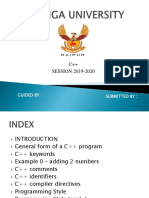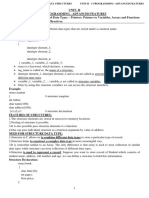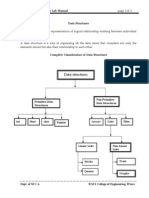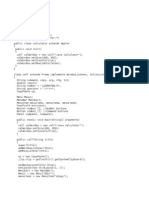Python Personality Quiz
Uploaded by
Kelly LougheedPython Personality Quiz
Uploaded by
Kelly LougheedPython Personality Quiz
You will make a personality quiz that will give the user a result based on if they picked mostly
A’s, mostly B’s, or mostly C’s!
After you’ve planned out your quiz (you must have at least three questions and three answers),
dive into the code:
1. Create variables to store the number of A answers, B answers, and C answers.
a_count = 0
b_count = 0
c_count = 0
2. Have the program ask a question and get an answer from the user.
q1_answer = input("How would you describe yourself? a)
brave, b) loyal, or c) smart?")
3. Based on the user’s answer, have the program increment either a_count, b_count, or
c_count.
if q1_answer.lower() == 'a':
a_count += 1
elif q1_answer.lower() == 'b':
b_count += 1
elif q1_answer.lower() == 'c':
c_count +=1
else:
print("Sorry, I don't understand that response.")
4. Repeat steps 2-3 for each question.
5. Calculate which of a_count, b_count, or c_count is highest, and give the user the results.
if a_count > b_count and a_count > c_count:
print("You're Harry Potter!")
elif b_count > a_count and b_count > c_count:
print("You're Ron Weasley! ")
elif c_count > a_count and c_count > b_count:
print("You're Hermione Granger! ")
else:
print("Wow, you're a combination of all three: Harry,
Ron, and Hermione! ")
Extensions
1. Add more options and results to your quiz. Give an explanation for each result.
2. Use a dictionary to keep track of a, b, and c counts. Then loop through the dictionary to
find the variable with the highest count at the end.
3. Use a function that takes in a parameter of the user’s answer and allows you to reuse
the code in step #3.
You might also like
- Hourglass Workout Program by Luisagiuliet 276% (21)Hourglass Workout Program by Luisagiuliet 251 pages
- The Hold Me Tight Workbook - Dr. Sue Johnson100% (16)The Hold Me Tight Workbook - Dr. Sue Johnson187 pages
- Read People Like A Book by Patrick King-Edited62% (66)Read People Like A Book by Patrick King-Edited12 pages
- Livingood, Blake - Livingood Daily Your 21-Day Guide To Experience Real Health77% (13)Livingood, Blake - Livingood Daily Your 21-Day Guide To Experience Real Health260 pages
- COSMIC CONSCIOUSNESS OF HUMANITY - PROBLEMS OF NEW COSMOGONY (V.P.Kaznacheev,. Л. V. Trofimov.)94% (212)COSMIC CONSCIOUSNESS OF HUMANITY - PROBLEMS OF NEW COSMOGONY (V.P.Kaznacheev,. Л. V. Trofimov.)212 pages
- Donald Trump & Jeffrey Epstein Rape Lawsuit and Affidavits83% (1016)Donald Trump & Jeffrey Epstein Rape Lawsuit and Affidavits13 pages
- The 36 Questions That Lead To Love - The New York Times94% (34)The 36 Questions That Lead To Love - The New York Times3 pages
- The 36 Questions That Lead To Love - The New York Times95% (21)The 36 Questions That Lead To Love - The New York Times3 pages
- Jeffrey Epstein39s Little Black Book Unredacted PDF75% (12)Jeffrey Epstein39s Little Black Book Unredacted PDF95 pages
- The 4 Hour Workweek, Expanded and Updated by Timothy Ferriss - Excerpt23% (954)The 4 Hour Workweek, Expanded and Updated by Timothy Ferriss - Excerpt38 pages
- Workshop - Week 8 Mysql Practical ExerciseNo ratings yetWorkshop - Week 8 Mysql Practical Exercise3 pages
- Chapter 5 Solutions - Objects First With JavaNo ratings yetChapter 5 Solutions - Objects First With Java8 pages
- HTML Quiz Questions and Answers - QualityPoint TechnologiesNo ratings yetHTML Quiz Questions and Answers - QualityPoint Technologies15 pages
- CSC290 Critical Review Grading Rubric: A 8-10 B 7-7.9 C 6-6.9 D 5-5.9 F 5 Summary (20%)No ratings yetCSC290 Critical Review Grading Rubric: A 8-10 B 7-7.9 C 6-6.9 D 5-5.9 F 5 Summary (20%)2 pages
- Data Structures and Algorithms AssignmentNo ratings yetData Structures and Algorithms Assignment8 pages
- Object Oriented Programming: Objects and ClassesNo ratings yetObject Oriented Programming: Objects and Classes19 pages
- Shell Script To Check Whether A String Is Palindrome or NotNo ratings yetShell Script To Check Whether A String Is Palindrome or Not13 pages
- Software Testing Interview Questions and AnswersNo ratings yetSoftware Testing Interview Questions and Answers6 pages
- UNIT-5 File Management in C: There Are Two Types of Files in C LanguageNo ratings yetUNIT-5 File Management in C: There Are Two Types of Files in C Language12 pages
- Aindumps.98 381.v2018!07!27.by - Donna.21qNo ratings yetAindumps.98 381.v2018!07!27.by - Donna.21q27 pages
- Sumita Arora Classes and Objects Long Answer Questions75% (4)Sumita Arora Classes and Objects Long Answer Questions10 pages
- Corelight Zeek Logs Cheatsheet Version 2.6 PDFNo ratings yetCorelight Zeek Logs Cheatsheet Version 2.6 PDF6 pages
- Important C Questions For Written Test & Interview by Crack The Interview100% (8)Important C Questions For Written Test & Interview by Crack The Interview236 pages
- Data Types, Operators, and Expressions: For Multiple-Choice and Essay QuestionsNo ratings yetData Types, Operators, and Expressions: For Multiple-Choice and Essay Questions6 pages
- Lab Assignment #4 - C# Methods: Firstname-Lastname - Labnumber0% (1)Lab Assignment #4 - C# Methods: Firstname-Lastname - Labnumber2 pages
- Dictionary Question -Practice Questions (1)No ratings yetDictionary Question -Practice Questions (1)6 pages
- Java Methods (Subgoal-Labeled Worked Examples)No ratings yetJava Methods (Subgoal-Labeled Worked Examples)6 pages
































































































